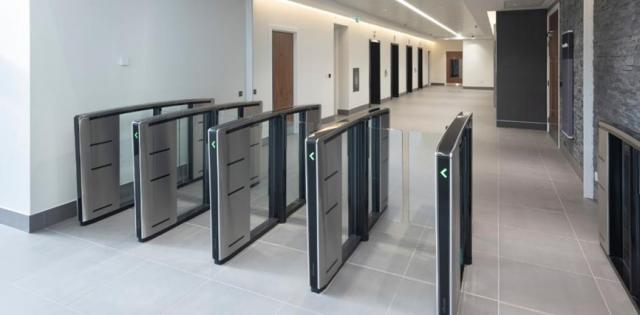Balancing openness with protection: designing for security and accessibility
Building security demands have risen dramatically in a world characterised by increasing polarisation, technological advancements, extremism and growing distrust. Industries that once required only moderate protection now face heightened risks, with threats extending beyond government buildings and data centres.
To address these ongoing threats, global security entrance specialist Boon Edam has released its 2025 Security Trend Report, which explores current security entrance trends and provides insights on how to stay ahead in an unpredictable environment.
“As with all evolving solutions, there is a fine balance to be found here, where we want people to feel open and welcome, but we need to have robust security measures in place to deal with the harsh realities that may occur,” says Boon Edam Australia Managing Director, Michael Fisher.
“Building professionals, including owners and managers, have a duty of care to minimise risk and protect workers and visitors from harm whilst in their buildings. There may be legal implications for those found not to be meeting their statutory requirements,” he adds.
Boon Edam’s latest security trend report identifies the key trends shaping the future of secure entrances, including:
Bridging the gap: physical security meets cyber security
Security today is no longer confined to stopping unauthorised access at the door or protecting IT networks. A unified approach – where physical entry solutions work hand-in-hand with digital safeguards – is essential. This integration is especially vital in high-stakes environments such as data centres, government buildings, corporate headquarters, and critical infrastructure.
One emerging standard driving this shift is Zero Trust Architecture, which limits access to only those users and devices authorised for specific tasks, both physically and digitally. By adopting Zero Trust principles, organisations ensure every access point – whether a server room or revolving door – is tightly controlled, verified, and monitored in real-time.
Zero Trust principles are especially critical in high-stakes environments like data centres, where any security failure can have severe consequences.
Adapting to evolving regulations: NIS2 and cyber resilience act
New EU regulations are raising the bar for cybersecurity, with direct implications for physical security systems. The NIS2 Directive mandates stricter cyber protocols across essential sectors like energy, healthcare, and transport, requiring enhanced risk management, incident reporting, and supply chain protections.
Meanwhile, the Cyber Resilience Act (CRA) introduces stringent requirements for products with digital components, including IoT-enabled security entrances. Manufacturers must embed cyber protections throughout the product lifecycle – from design to ongoing updates – ensuring resilience against evolving cyber threats.
These regulations set new benchmarks for compliance and accountability, and provide a framework for Australasia to follow.
Creating dynamic security ecosystems
Modern buildings require a layered approach to security. High-security zones, such as server rooms, are now equipped with biometric authentication, encrypted communication protocols, and automated, unattended entry solutions. Medium-security areas, like administrative floors, leverage speed gates and advanced sensors to balance efficiency with security, while public spaces prioritise openness without compromising monitored access.
This multi-layered strategy mirrors principles found in cyber security – like multi-factor authentication – where each layer serves as a fail-safe, ensuring comprehensive protection.
Rise of explosion and impact resistance
Emerging risks – ranging from terrorism to civil unrest – have broadened the industries seeking advanced physical protections. Explosion-resistant and impact-resistant materials, such as reinforced steel, shatterproof glass, and polycarbonate layers, are now key components of modern entrance systems. These innovations not only protect occupants but also mitigate the financial and reputational costs of downtime due to forced entry or vandalism.
AI and predictive analytics transform security operations
Artificial intelligence (AI) continues to reshape how security systems operate. AI-powered entry solutions now offer real-time threat detection, predictive analytics, and automation – allowing facilities like airports, hospitals, and corporate buildings to stay one step ahead of potential threats.
AI also enhances biometric authentication, introducing sophisticated technologies like vein pattern analysis and heartbeat recognition for sensitive environments. Yet, human expertise remains critical. The most effective strategies combine AI-driven insights with human oversight, ensuring smarter, ethical, and well-balanced security decisions.
Sustainability at the forefront
Security entrances are increasingly designed with sustainability in mind. Energy-efficient motors, low-power IoT components, and smart sensors reduce power consumption without compromising protection. Revolving doors, for example, contribute to regulating indoor climates and achieve high ratings with systems such as NABERS and Green Star.
Retrofitting existing entrances – through targeted modifications or full upgrades – also aligns security investments with long-term environmental goals, extending product lifespans and reducing waste.
Real-time monitoring and IoT integration
The integration of IoT-enabled systems and protocols like Open Supervised Device Protocol (OSDP) is transforming building security. These technologies simplify wiring and system connectivity, ensuring seamless communication between access control, building management, and fire safety systems.
Furthermore, real-time monitoring and predictive maintenance, powered by IoT, offer facility managers unprecedented oversight. By addressing performance issues before they escalate, businesses reduce downtime, lower maintenance costs, and optimise operational efficiency.
Building for the future
By prioritising the convergence of physical and digital security, and incorporating innovative materials and AI-driven insights, organisations can create safe, welcoming, and resilient environments.
As security challenges continue to grow, businesses that embrace these trends will be best positioned to protect their people, assets, and reputations in the years ahead.
For further in-depth analysis, read Boon Edam’s full 2025 Security Trend Report.

